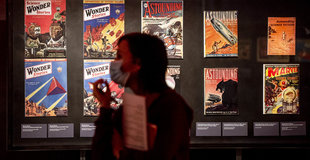The CCCB lands on Mars
Without intending to, NASA has run the best promotion campaign possible for the new exhibition at Barcelona’s Centre of Contemporary Culture, the CCCB. While the world watched the rover Perseverance land on Mars, the CCCB was preparing its ambitious exhibition about the Red Planet, which will run until July 11.
It is a magnificent coincidence, as the exhibition was supposed to open last autumn but was delayed due to the pandemic. Unlike Nasa’s expedition, Mart. The Mirall Vermell (Mars. The Red Planet) “is not a science exhibition,” warns the CCCB’s director, Judit Carrera. Not that the exhibition avoids science, but rather it interrelates with other disciplines, such as philosophy, literature and art. If there is no one way to understand the world, there is also no one way to understand the planet that was born 4.6 billion years ago.
The exhibition aims to be a “narrative of narratives” that feed into each other, insists the centre’s head of exhibitions, Jordi Costa, who points out that humanity has always looked to the sky to find answers to the enigmas of its existence.
“Under different names, all ancient cultures invoked Mars,” says curator, Juan Insua. Mars was Nergal to Mesopotamia, Harmakhis in Egypt, Mangala in Hindu mythology, Guan Yu in the Chinese tradition, and Ares to the Greeks. “All refer to a divine power associated with war and violent masculinity,” adds Insua.
Yet it was the Romans who gave Mars the name we know it by today, and they also added a new aspect. Mars may have been a terrible and frightening deity, but he also acted as the protector of Roman harvests when he awoke in March, the month that bears his name. From then on, Mars would become synonymous with both death and life. This is one of the main themes that the CCCB’s exhibition draws on its vision of the Red Planet.
The possibility of whether Mars, without oxygen or liquid water, can be colonised by future generations is also in the exhibition, although that is not what it is about. What it is about, say the organisers, is looking at how we have mentally and emotionally approached the planet’s singular presence in the solar system and turned it into an icon. “Does Mars explain us?” is the question that this project asks, says Costa.
More than 400 works (books, sculptures, drawings, photographs, comics, movies...) have been used for the exhibition to trace this “cultural history”, a history in which the boundaries between past, present and future are constantly diluted, in the same way as are the limits between fantasy and reality.
art visual culture






